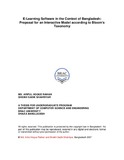| dc.contributor.advisor | Rahman, A S M Zillur | |
| dc.contributor.author | Raihan, Ariful Hoque | |
| dc.contributor.author | Shahriyar, Sheikh Sadik | |
| dc.date.accessioned | 2010-10-07T10:24:29Z | |
| dc.date.available | 2010-10-07T10:24:29Z | |
| dc.date.copyright | 2007 | |
| dc.date.issued | 2007 | |
| dc.identifier.other | ID 02201035 | |
| dc.identifier.other | ID 02201040 | |
| dc.identifier.uri | http://hdl.handle.net/10361/385 | |
| dc.description | This thesis report is submitted in partial fulfillment of the requirements for the degree of Bachelor of Science in Computer Science and Engineering, 2007 | en_US |
| dc.description | Cataloged from PDF version of thesis report. | |
| dc.description | Includes bibliographical references (page 62). | |
| dc.description.abstract | The latest information and communication technologies like internet service, telecom service, and live video conference have introduced a special form of distance learning: e-learning which removes the barriers of traditional learning system like time limitation, fixed scheduling, physical distance and other cost factors. Distance Learning is commonly used due to its flexibility, and efficiency.
Increasing its instant feedback can maximize the effectiveness. In Bangladesh the e-learning system is very new and some e-learning software has been developed till date. Again, the success of distance learning depends on learners’ interest and that is reinforced by the interactivity of the learning system. In our thesis-survey we have found that most of Bangladeshi software has a common tendency of only gathering and presenting information. But lack of feedback,
structural inefficiency and lack of response process can pose threat to the acceptance of distance learning. So our goal is to formulate a design of a distance-learning model, which can maximize the interactivity. | en_US |
| dc.description.statementofresponsibility | Md. Ariful Hoque Raihan | |
| dc.description.statementofresponsibility | Sheikh Sadik Shahriyar | |
| dc.format.extent | 63 pages | |
| dc.publisher | BRAC University | en_US |
| dc.rights | BRAC University thesis are protected by copyright. They may be viewed from this source for any purpose, but reproduction or distribution in any format is prohibited without written permission. | |
| dc.subject | E-learning | en_US |
| dc.subject | Distance learning | en_US |
| dc.subject | Blooms-taxonomy | en_US |
| dc.subject | Psychomotor | en_US |
| dc.subject | Cognitive | en_US |
| dc.subject | Affective | en_US |
| dc.subject | Computer science and engineering | |
| dc.title | E-learning software in the context of Bangladesh : proposal for an interactive model according to bloom's texonomy | en_US |
| dc.type | Thesis | en_US |
| dc.contributor.department | Department of Computer Science and Engineering, BRAC University | |
| dc.description.degree | B. Computer Science and Engineering | |

